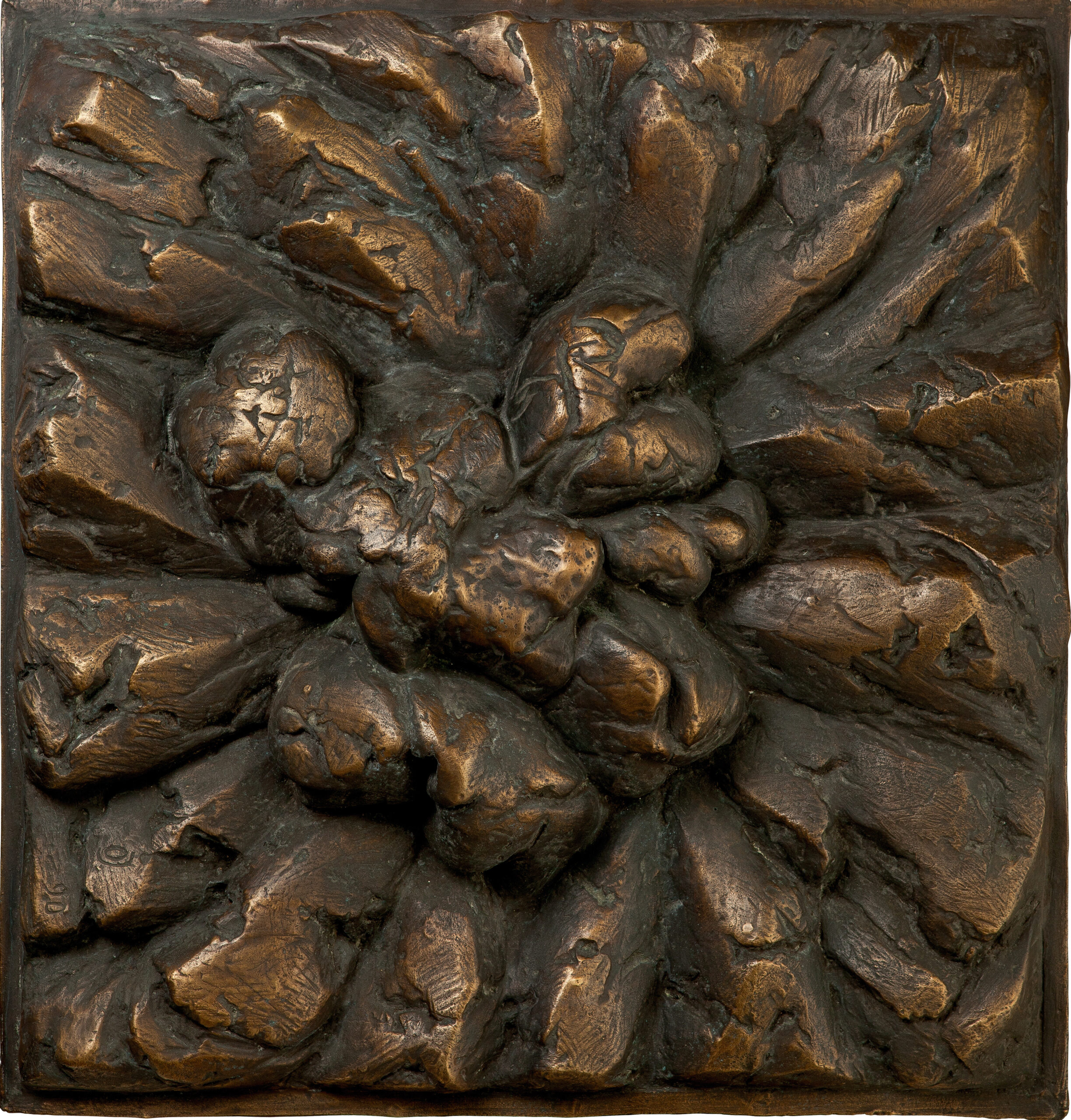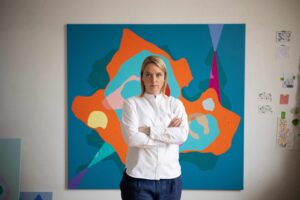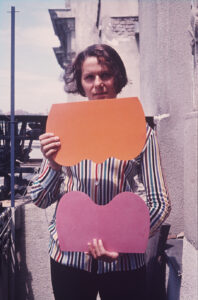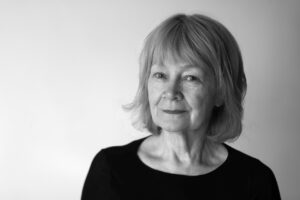Olga Jančić
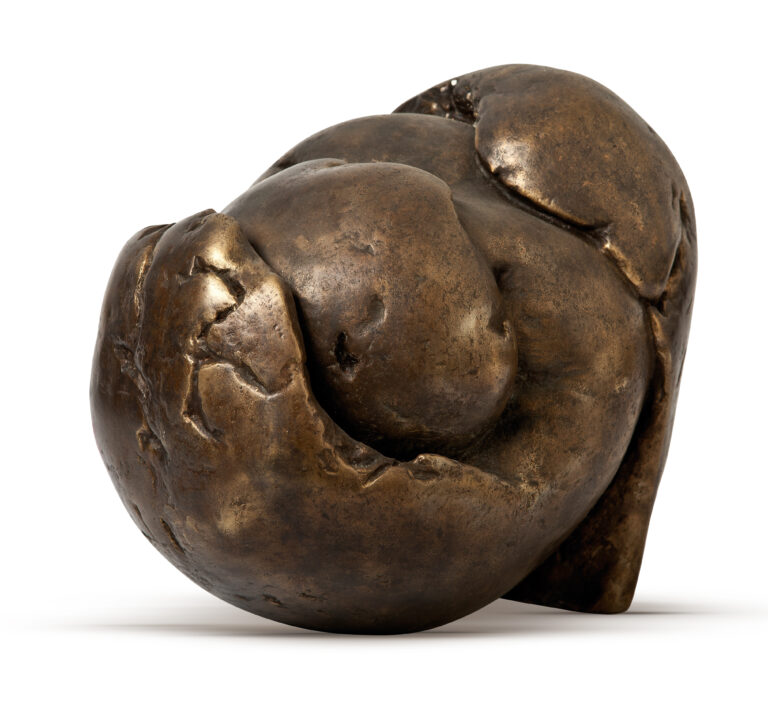
– born in 1929 in Bitola, the Kingdom of Serbs, Croats and Slovenes, and grew up and lived in Belgrade, Serbia where she passed away in 2012. She graduated from the Academy of Fine Arts, the sculpture department, in Belgrade (1950) in the class of professors Lojze Dolinar and Toma Rosandić. After graduation she completed her specialisation in sculpture in the Master Workshop of Toma Rosandić (1950-1954). She was one of the founders of the art group Space 8 (1957). In 1959 she received a scholarship for an artistic residency in Paris and London. At the time she won a prize at the first Youth Biennial in Paris, and during her stay in London she visited Henry Moore’s studio. Her first solo exhibition was in Belgrade (1959). Her artworks were exhibited in her home country as well as abroad, and she represented Yugoslavia at the 21st Venice Biennial (1962). She has received numerous prizes for her works and her artworks have been presented, amongst other publications, in following books on modern sculpture such as Michel Seuphor “La Sculpture de ce siècle” (1959) and Herbert Read’s “A Concise History of Modern Sculpture” (1964).
Olga Janičić, “The Fruit VIII, sculpture, 1975, courtesy of the Gallery of Matica Srpska.
The sculptress Olga Jančić1 began her oeuvre at the moment in Yugoslav art when it was characterised by avant-garde revolutionary aesthetics. A pragmatic example of her work was exhibited at the Yugoslav pavilion at the Brussels World’s Fair – EXPO 58 at which Olga Jančić was one of the artists presented. The key figure behind the conceptualisation of this pavilion was the architect Vjenceslav Richter, and it was realised in collaboration with Aleksandar Srnec and Emil Weber. The pavilion was made in such a way to reflect the process of rapid modernisation, progress and openness, as well as to refer to the socially engaged avant-gardes of the interwar period. It consisted of three galleries – the State and Social Organisation, Contemporary Art, the Economy and Tourism. In front of the pavilion a steel cable was mounted composed of six vertical arches symbolizing the six republics constituting Yugoslavia, while the pavilion’s external surfaces were composed of sculptures, reliefs and murals and combined with pools of water, vibrant marble pathways and greenery that added up to the entire aesthetic atmosphere2. Among the exhibited artworks there was also the sculpture entitled “Composition” by the then young artist Olga Jančić. This was the historical moment in which Yugoslav cultural policy was turning towards Western Europe and the USA as witnessed by numerous artistic events such as guest lectures by Herbert Read and the artists that were representatives of Vitalism – Constantin Brâncuși, Henri Laurens, Nikolaus Pevsner, Joan Miró, Barbara Hepworth, Henry Moore and others. They exerted a particular influence on the representatives of the new generation of modernist sculptors in Yugoslavia, and Olga Jančić was certainly amongst these.
Olga Jančić made her sculptures mostly in stone or marble, but also in onyx, bronze, aluminum, gypster, and wood. During the 1960s and 1970s the influence of the abovementioned European sculpture, and especially of Brâncuși, Miró and Arp, was noticeable in the works of Olga Jančić, in her organic treatment of the shaping typology combined with the principles of the vital forms of archetypal symbols which defined her long standing expressive orientation, for which reason she is considered a representative of organic sculpture on the local scene. Her organic forms of associative nature come to their full fruition in external spaces. Critics have described Olga Jančić’s artworks from this period as sensual and erotic, such as the sculptures “Sculpture 1” (1960) or “Maternity”3 (1957). Olga Jančić entered her mature modernist phase during the 1970s and 1980s in which her keen sense for mass, space and materials is emphasised4. These sculptures are characterised by their voluminous mass as in the artworks such as “Totem” or “Medallion” (1961) which were exhibited at the Venice Biennial. The compact core and the distributed mass that opens up around it is also characteristic of this period of her activity5 and is evident in the sculpture “Fruit I, Core” in cast bronze (1967). By the end of the 1980s and the beginning of the 1990s her characteristic Vitalist form underwent a change when social changes and problems became integrated into her work. The best examples of this change are the reliefs she presented in September 1991 in her solo exhibition in the Cultural Center of Belgrade dealing with the topics of aggression, such as “At the Edge” (1988), “Advancement” (1990), “Pulsating”6 (1990), “Out of Balance” (1985), “Unstable Core” (1990) and others.
Olga Jančić was one of the few female sculptors in Yugoslav art of the second part of the 20th century, on which her works left an imprint. Her first retrospective exhibition was held in 1987 at the Museum of Contemporary Art in Belgrade, and the next in the Museum 25th May in Belgrade. She entrusted her legacy consisting of 90 sculptures from her oeuvre to the Parliament of Belgrade.
Mirjana Dragosavljević (2022).
1Reference: Irina Subotić and Ivana Simeonović Ćelić, Olga Jančić, Clio, Belgrade, 19972Reference: Vladimir Kulić, “Between Wars, Between Blocks: Yugoslavia at EXPO 58“ in: Architecture of Great Expositions 1937-1959, Messages of Peace, Images of Wars, edited by Rika Devos, Alexander Ortenberg and Vladimir Paperny, Ashgate, 2015
3Illustration: Olga Jančić, “Maternity”, sculpture, 1957, photo: Saša Reljić, courtesy of the Museum of Contemporary Art Belgrade.
4Reference: “Thoughts on Olga Jančić’s Sculptures – Limits of Modernism” in the catalog of the retrospective exhibition Legacy of Olga Jančić held in the gallery of the House of Legacies from 27th April to 9th June 2018. The authors of the textual contributions in the catalog are: Dejan Vučetić, Dina Pavić and Katarina Kostandinović, editor: Dejan Vučetić, review: Suzana Vuksanović
5Illustration: Ogla Jančić, “Core”, sculpture, 1968/69, photo: Bojana Janjić, courtesy of the Museum of Contemporary Art Belgrade.
6Illustration, Olga Jančić, “Pulsating”, sculpture, 1990, courtesy of the Gallery of Matica Srpska.
– rođena je u 1929. godine u Bitolju u Kraljevini Srba, Hrvata i Slovenaca, a odrasla je i živela u Beogradu u Srbiji, gde je i umrla 2012. godine. Diplomirala je na vajarskom odseku na Akademiji likovnih umetnosti u Beogradu (1950) kod profesora Lojza Dolinara i Tome Rosandića. Nakon završenih studija bila je na specijalizaciji u Majstorskoj radionici Tome Rosandića (1950-54). Jedna je od osnivača grupe „Prostor 8“ (1957). Dobitnica je stipendije za boravak u Parizu i Londonu (1959). U Parizu je tada dobila nagradu na prvom Bijenalu mladih; u Londonu je bila u poseti studiju Henry-ja Moore-a. Prvu samostalnu izložbu imala je u Beogradu (1959). Izlagala je u zemlji i inostranstvu, predstavljala je Jugoslaviju na 21. Bijenalu u Veneciji (1962), dobitnica je mnogobrojnih nagrada. Njeni radovi predstavljeni su, između ostalog, u knjigama o modernoj skulupturi: Michel Seuphor, „La Sculpture de ce siècle „(1959) i Herbert Read, „A Concise History of Modern Sculpture“ (1964).
Olga Jančić, „Plod VIII“, skulptura, 1975, ljubaznošću Galerije Matice Srpske.
Skulptorka Olga Jančić1 započinjala je svoj opus u trenutku koji je u jugoslovenskoj umetnosti obeležen avangardnom estetikom revolucionarne konotacije za šta je paradigmatični primer Paviljon Jugoslavije na Svetskoj izložbi u Briselu – EXPO 58, u okviru kojeg je Olga Jančić bila jedna od izlagačica. Ključna ličnost u konceptualizaciji ovog paviljona bio je arhitekta Vjenceslav Rihter, a radio je u saradnji sa Aleksandrom Srnecom i Emilom Weberom. Paviljon je koncipiran tako da odaje sliku ubrzane modernizacije, progresa, otvorenosti, i da referiše na društveno-angažovane avangarde međuratnog perioda i sastojao se od četiri galerije – Državna i društvena organizacija, Savremena umetnost, Ekonomija i Turizam. Ispred paviljona bio je postavljen čelični kabl sastavljen od šest vertikalnih lukova koji su simbolizovali šest konstitutivnih republika Jugoslavije, a spoljašnjost paviljona je bila sastavljena od skulptura, reljefa i murala uklapanih sa vodenim bazenima, živopisnim mermernim stazama i zelenilom koje je doprinosilo čitavoj estetskoj atmosferi2. Među izloženim radovima bila je i skulptura „Kompozicija“, tada mlade umetnice Olge Jančić. U pitanju je istorijski trenutak u kojem se jugoslovenska kulturna politika okreće Zapadnoj Evropi i SAD-u o čemu svedoče brojni događaji iz oblasti umetnosti, među kojima su posete kritičara poput Herbert-a Read-a, izložbe i gostovanja umetnika poput predstavnika vitalizma: Constantin-a Brâncuși-ja, Henri-ja Laurens-a, Nikolaus-a Pevsner-a, Joan-a Miró-a, Barbara-e Hepworth, Henry-ja Moore-a i drugih, koji su ostvarili izvestan uticaj na predstavnike nove generacije modernističkih skulptora u Jugoslaviji, među koje se svakako ubraja i Olga Jančić.
Olga Jančić je svoje skulpture i reljefe najčešće izvodila u kamenu, mermeru, ali i oniksu, bronzi, aluminijumu, gipsu i drvetu. Tokom šezdesetih i sedamdesetih godina prošlog veka u stvaralaštvu Olge Jančić primetan je uticaj pomenute evropske skulpture, pre svega Brankuzija, Mura i Arpa: tretiranje forme organske oblikovne tipologije u kombinaciji sa principima vitalne forme arhetipskih simboličnih potencijala, što je definisalo njenu trajnu orijentaciju u izrazu, pa se zato ona smatra predstavnikom organske skulpture kod nas. Njene organske forme asocijativne prirode u eksterijeru dostižu svoju punoću, a radove Olge Jančić iz ovog perioda kritičari često opisuju kao senzualne i erotične poput skulptura kao što su „Skulptura 1“ (1960) ili „Materinstvo“3 (1957). U sedmoj i osmoj deceniji prošlog veka, radovi Olge Jančić dostižu svoju zrelu modernističku fazu u kojoj je naglašen osećaj za masu, prostor i materijal4. Ove skulpture karakteriše voluminozna masa, kao u radovima „Totem“ ili „Medaljon“ (1961), koji su izloženi na Bijenalu u Veneciji. Kompaktno jezgro i razuđena masa koja se oko njega otvara takođe je karakteristična za ovaj period njenog stvaralaštva5, što se vidi u skulpturi „Plod I, Jezgro“, livena bronza (1967). Krajem osamdesetih, početkom devedestih godina, njena karakteristična vitalistička forma se menja, a društvene promene i problemi odražavaju se i u njenom radu, što se najbolje vidi u reljefima koje je izložila u septembru 1991. godine na samostalnoj izložbi u Kulturnom centru Beograda, a u kojima obrađuje temu agresije, među kojima su „Na oštrici“ (1988), „Nadiranje“ (1990), „Pulsiranje“6 (1990), „Van težišta“ (1985), „Ugroženo jezgro“ (1990) i drugi.
Olga Jančić bila je jedan od malobrojnih žena skulptorki i njeni radovi obeležili su jugoslovensku umetnost druge polovine 20. veka. Njena prva retrospektivna izložba održana je 1987. u Muzeju savremene umetnosti u Beogradu, a naredna 2005. godine u Muzeju “25. maj” u Beogradu. Predala je Skupštini Beograda legat od 90 skulptura iz svog opusa.
Mirjana Dragosavljević (2022).
1Referenca: “Olga Jančić“, Irina Subotić i Ivana Simeonović Ćelić, Clio, Beograd, 1997.2Referenca: Vladimir Kulić, Between Wars, Between Blocks: Yugoslavia at EXPO 58, u: „Architecture of Great Expositions 1937-1959, Messages of Peace, Images of Wars“, Edited by Rika Devos, Alexander Ortenberg and Vladimir Paperny, ASHGATE, 2015
3Ilustracija: OIga Jančić, “Materinstvo”, skulptura, 1957, foto: Saša Reljić, ljubaznošću Muzeja savremene umetnosti Beograd.
4Razmišljanja o skulpturi Olge Jančić – granice modernizma u katalogu retrospektivne izložbe "Legat Olge Jančić", održane u Galeriji Kuće legata od 27. aprila do 9. juna 2018. godine. Autori tekstova u katalogu: Dejan Vučetić, Dina Pavić i Katarina Kostandinović / Urednik: Dejan Vučetić / Recenzent: mr Suzana Vuksanović.
5Ilustracija: Olga Jančić, “Jezgro oblika”, skulptura, 1968/69, foto: Bojana Janjić, ljubaznošću Muzeja savremene umetnosti Beograd.
6Ilustracija: Olga Jančić, “Pulsiranje”, skulptura, 1990, ljubaznošću Galerije Matice Srpske.
